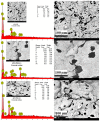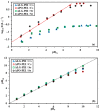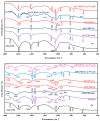Phosphonation of Alginate-Polyethyleneimine Beads for the Enhanced Removal of Cs(I) and Sr(II) from Aqueous Solutions
- PMID: 36826322
- PMCID: PMC9957171
- DOI: 10.3390/gels9020152
Phosphonation of Alginate-Polyethyleneimine Beads for the Enhanced Removal of Cs(I) and Sr(II) from Aqueous Solutions
Abstract
Although Cs(I) and Sr(II) are not strategic and hazardous metal ions, their recovery from aqueous solutions is of great concern for the nuclear industry. The objective of this work consists of designing a new sorbent for the simultaneous recovery of these metals with selectivity against other metals. The strategy is based on the functionalization of algal/polyethyleneimine hydrogel beads by phosphonation. The materials are characterized by textural, thermo-degradation, FTIR, elemental, titration, and SEM-EDX analyses to confirm the chemical modification. To evaluate the validity of this modification, the sorption of Cs(I) and Sr(II) is compared with pristine support under different operating conditions: the pH effect, kinetics, and isotherms are investigated in mono-component and binary solutions, before investigating the selectivity (against competitor metals) and the possibility to reuse the sorbent. The functionalized sorbent shows a preference for Sr(II), enhanced sorption capacities, a higher stability at recycling, and greater selectivity against alkali, alkaline-earth, and heavy metal ions. Finally, the sorption properties are compared for Cs(I) and Sr(II) removal in a complex solution (seawater sample). The combination of these results confirms the superiority of phosphonated sorbent over pristine support with promising performances to be further evaluated with effluents containing radionuclides.
Keywords: cesium; composite hydrogel; functionalization; metal sorption; modeling; reuse cycles; selectivity; sorption isotherm; strontium; uptake kinetics.
Conflict of interest statement
The authors declare no conflict of interest.
Figures































Similar articles
-
Amidoxime Functionalization of Algal/Polyethyleneimine Beads for the Sorption of Sr(II) from Aqueous Solutions.Molecules. 2019 Oct 29;24(21):3893. doi: 10.3390/molecules24213893. Molecules. 2019. PMID: 31671819 Free PMC article.
-
New Process for the Sulfonation of Algal/PEI Biosorbent for Enhancing Sr(II) Removal from Aqueous Solutions-Application to Seawater.Molecules. 2022 Oct 21;27(20):7128. doi: 10.3390/molecules27207128. Molecules. 2022. PMID: 36296719 Free PMC article.
-
As(V) sorption from aqueous solutions using quaternized algal/polyethyleneimine composite beads.Sci Total Environ. 2020 Jun 1;719:137396. doi: 10.1016/j.scitotenv.2020.137396. Epub 2020 Feb 20. Sci Total Environ. 2020. PMID: 32143096
-
Layered metal sulfides with MaSbc- framework (M = Sb, In, Sn) as ion exchangers for the removal of Cs(Ⅰ) and Sr(Ⅱ) from radioactive effluents: a review.Front Chem. 2023 Dec 6;11:1292979. doi: 10.3389/fchem.2023.1292979. eCollection 2023. Front Chem. 2023. PMID: 38124703 Free PMC article. Review.
-
Recent developments in nanostructured inorganic materials for sorption of cesium and strontium: Synthesis and shaping, sorption capacity, mechanisms, and selectivity-A review.J Hazard Mater. 2018 Feb 15;344:511-530. doi: 10.1016/j.jhazmat.2017.10.047. Epub 2017 Oct 24. J Hazard Mater. 2018. PMID: 29100131 Review.
Cited by
-
Multifaceted biomedical applications of biogenic titanium dioxide nanoparticles fabricated by marine actinobacterium Streptomyces vinaceusdrappus AMG31.Sci Rep. 2025 Jun 23;15(1):20244. doi: 10.1038/s41598-025-00541-1. Sci Rep. 2025. PMID: 40550842 Free PMC article.
-
An Eco-Friendly Approach Utilizing Green Synthesized Titanium Dioxide Nanoparticles for Leather Conservation against a Fungal Strain, Penicillium expansum AL1, Involved in the Biodeterioration of a Historical Manuscript.Biology (Basel). 2023 Jul 20;12(7):1025. doi: 10.3390/biology12071025. Biology (Basel). 2023. PMID: 37508454 Free PMC article.
-
A Review of Patents and Innovative Biopolymer-Based Hydrogels.Gels. 2023 Jul 7;9(7):556. doi: 10.3390/gels9070556. Gels. 2023. PMID: 37504436 Free PMC article. Review.
References
-
- RSC Periodic Table. [(accessed on 5 May 2021)]. Available online: https://www.rsc.org/periodic-table/
-
- Fiskum S.K., Colburn H.A., Rovira A.M., Allred J.R., Smoot M.R., Peterson R.A., Landon M.R., Colosi K.A. Cesium removal from AP-105 Hanford tank waste using spherical resorcinol formaldehyde resin. Sep. Sci. Technol. 2019;54:1932–1941. doi: 10.1080/01496395.2019.1577273. - DOI
Grants and funding
LinkOut - more resources
Full Text Sources
Research Materials

